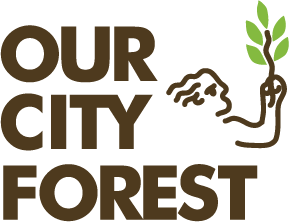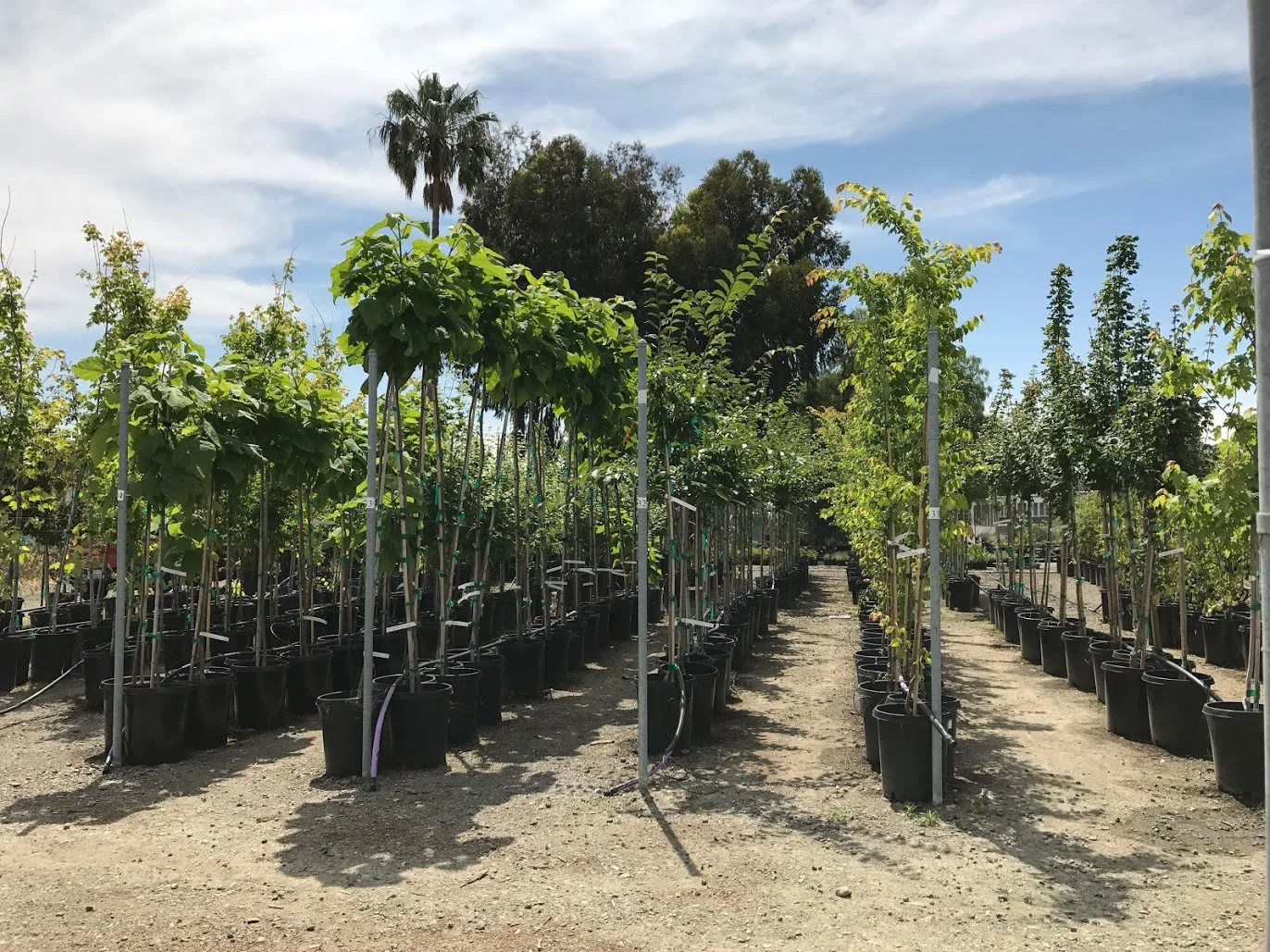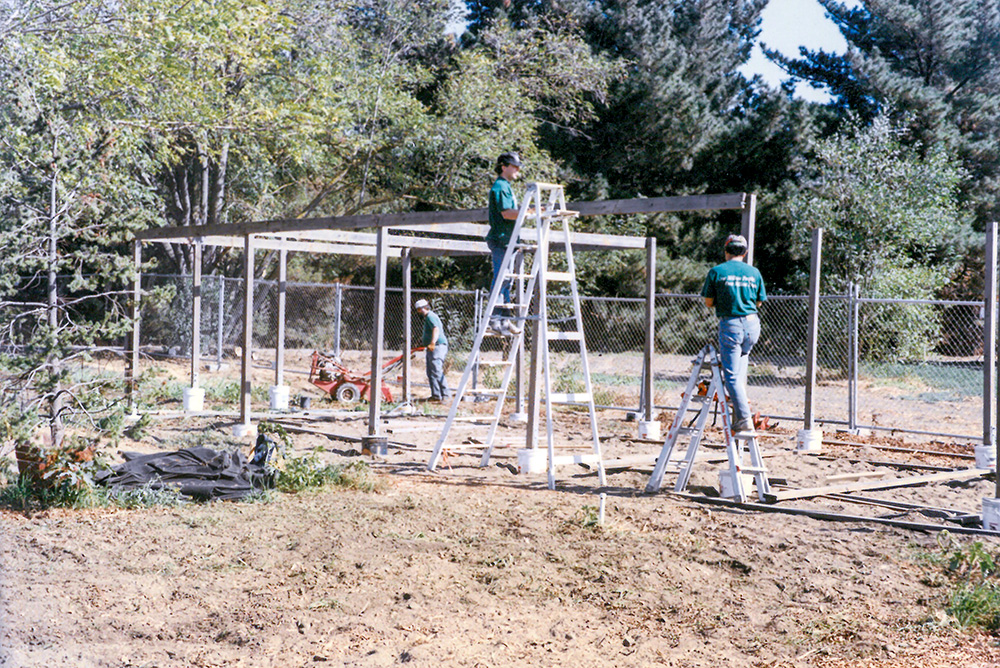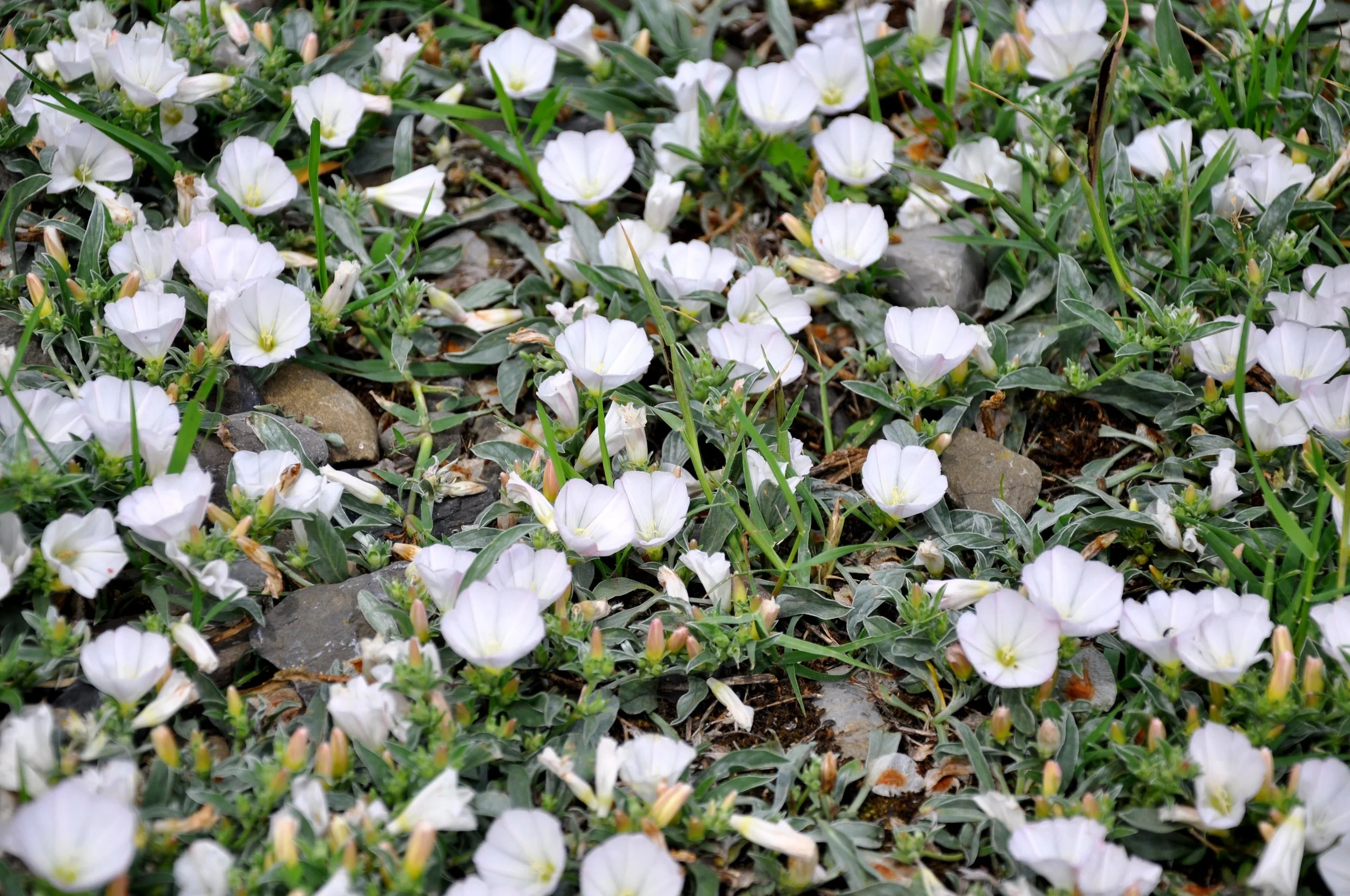Our City Forest is proud to present the newest addition to our parcel at Martial Cottle Farm Park, a California Native Garden. This garden showcases seven of California’s most common ecosystems by grouping native shrubs together based on their typical habitat. The goal of this garden is to educate visitors about native plants/ecosystems, and provide them with inspiration for using natives in their own landscape!
Our City Forest’s Community Nursery and Training Center is situated on two acres near Mineta San Jose International Airport. It is home to some 2,350 young trees and 6,300 shrubs, nearly all of which were cultivated on site. The trees alone fill 38 rows spread across two large sections or ‘banks.’ In addition to its stock of plants, the Nursery keeps on hand sufficient planting materials and equipment to conduct regular community plantings of dozens of trees at a time. The Nursery also serves as a training site for AmeriCorps service members, Tree Amigos, tree stewards, and other community volunteers.
Our City Forest (OCF) has not always had a cultivation nursery to support its mission of greening Silicon Valley and engaging volunteers. The land that the Nursery leases today on Spring Street was made available by the City of San Jose in 2010, many years after CEO Rhonda Berry founded the nonprofit in 1994. A look at Our City Forest’s operation before it acquired the Nursery underscores just how valuable it is to OCF today. The Nursery enables OCF to control the supply, quality, and species of the trees and shrubs it wishes to plant, all while expanding its community of volunteers.
The beginning of the Watson Park Tree Bank shade structure.
Back in the day, OCF had to rely on wholesale nurseries in Sunol and the Central Valley for its trees. The wholesalers trucked the trees to an OCF “tree bank,” a storage yard for trees and supplies. They were located at a succession of sites in San Jose, first in Japantown then Watson and Kelly Parks. To get trees from the tree banks to the planting sites, OCF had to improvise. Rhonda estimates that OCF did not own trucks for the first 25,000 trees it planted. Instead, volunteers brought their own trucks to move trees, which resulted in headaches if their vehicles were dinged in the process. Volunteers also brought shovels and other necessary tools.
While the early plantings sometimes took unpredictable turns that had OCF flying by the seat of its pants, longtime Tree Amigo and Nursery Docent Judi Wilson remembers them fondly: “We had fun.”
The use of wholesalers and tree banks worked well enough that OCF was able to plant some 2,000 trees per year. However, the quality of trees received from the wholesalers was uneven and in many cases, some were unusable. As Staff Arborist Bo Firestone, who joined OCF in 2007, put it, “We would have trees delivered from a wholesale nursery perhaps the day before a project, and we might have to send half of them back. We then would be scrambling for last minute substitutions. Sometimes we wouldn’t even be able to plant all of the trees for a project because we had to reject some of them.”
The Watson Park Tree Bank shade structure.
The reasons for rejection varied. Trees arrived that were too small or too large for planting. Some were root bound or the roots were not developed sufficiently for planting. Some came with wounds or other damage, or structurally they were unsuitable. For example, some trees arrived topped, others lacked a strong central leader, and still others had been pruned into ‘lollipops’ - a popular conception of how mature trees should look that when imposed on young trees limits their access to photosynthates, the very thing that drives their growth.
Tree banks added another dimension of unpredictability. The availability of these sites was neither guaranteed nor always the best place to keep trees. For example, while using Watson Park to store trees, winter rains caused nearby Coyote Creek to flood. Christian Bonner, head arborist at the time, had the disquieting experience of watching the flood waters carry 6,000 donated tree seedlings downstream. Later, in 2005, OCF was forced to vacate the park when lead and other toxins from an old municipal dump were found in its topsoil, a discovery that closed the park for almost six years while it was cleaned. A 10 month delay in receiving approval for a new site from the City of San Jose limited OCF’s ability to plant trees. Volunteers were not allowed in the tree bank, and OCF, without AmeriCorps members in its early years, had only its staff available for plantings.
After the closure of Watson Park, OCF moved its tree bank to Kelly Park, a site that was large enough to accommodate both a shade house (built by Tree Amigos) and a limited amount of cultivation along with the usual stores of trees and equipment. As much as OCF members appreciated the charm of the park and the opportunity to grow plants, it would be OCF’s final tree bank. Bigger opportunities were in store for OCF, namely the chance to finally plant trees on privately owned, residential properties--a development that hitherto had been denied OCF and one with vast, untapped possibilities. It made a cultivating nursery, i.e., a place to grow the trees needed for residential planting, a necessity.
The Kelly Park Tree Bank.
For the first 15 years of its existence, Our City Forest relied on grants that stipulated OCF could plant only on public lands, such as parks and schools, or along streets. However, in 2007, the City of San Jose passed its Green Vision initiative that among other actions called for planting 100,000 trees by 2022, including on private property.
The OCF Team at the Kelly Park Tree Bank in 2008.
Rhonda Berry approached the City about its expansion of urban forestry goals, knowing the largest untapped planting area was within private yards. OCF and the City reaffirmed their partnership in greening San Jose through jointly leveraged resources, knowing that more varieties of trees were needed--and not to mention simply more trees! From this confluence of events and political support came the beginnings of Our City Forest’s Community Nursery, but much more funding and support would be required, and from outside San Jose.
In his book Weeds: In Defense of Nature’s Most Unloved Plants, English nature writer Richard Mabey states that plants that “obstruct our plans, or our tidy maps of the world” are weeds. The difference between weeds and what might be termed respectable plants is not so much botanical in nature but the result of human judgments on their respective value. Weeds grow where they are unwanted and crowd out the plants we deem valuable, such as crops and ornamental flowers, or they mar meticulously planned gardens. Mr. Mabey thus calls weeds “trespassers,” “vegetable guerillas,” “outlaws,” and botanical “fifth columnists.”
Weeds suffer in our estimation not only from their annoying invasiveness but also from the dismal places in which they live, namely among urban blight, environmental devastation, and trash dumps. In doing so weeds acquire the disrepute that more properly belongs to the slovenly people who debase the properties where they reside, what Mabey terms “guilt by association.” For example, In hardboiled detective stories, where cases often lead to badly maintained houses in sketchy neighborhoods, weeds abound alongside torn window screens, peeling paint, yellowed newspapers, litter, and rings of motor oil on the cracked driveways. Weeds are synonymous with neglect.
Kudzu vine.
However, they hardly are botanical bums. They are relentless opportunists that adapt and thrive where other plants cannot. They earn Mabey’s admiration for their persistence in adapting to whatever environment they find themselves in and the clever ways they go about doing so. “They are unfussy about where they live, adapt quickly to environmental stress, use multiple strategies for getting their own way. It’s curious that it took so long for us to realize that the species they most resemble is us.”
It has long been said that the only survivors of nuclear war will be cockroaches and Keith Richards. I put my money on weeds.
This is not to say that Mr. Mabey is entirely sold on the weed community by virtue of its ubiquity and determination to survive. For one thing, he notes the ugliness of many of its members. More serious is the rampant growth of superweeds such as kudzu, that are glyphosate-resistant, i.e., Roundup-tolerant. Superweeds spread from continent to continent and are frightening in not only their destructiveness and refusal to be controlled, but in some cases, their grotesque size. Horseweed grows to six feet high, and the Palmer amaranth reaches eight feet while developing a stem so tough it can damage farm machinery. Sound like a monster movie? In a desperate effort to halt the invasion of superweeds, newer herbicides have been developed, some of which even use components of the notorious Agent Orange.
Bindweed.
Our City Forest uses nontoxic measures to control weeds. Over the years Volunteers and AmeriCorps members have been a great help in hand weeding OCF’s Community Nursery and Martial Cottle acreage. In addition, weed cloths and mulch-covered cardboard are used at both sites. A recent blog related how OCF’s Lawn Busters effectively use cardboard and mulch in converting weed-ridden lawns to drought-resistant, weed-free xeriscapes.
So how did weeds acquire their tenacity? Why do they survive in places that are alien to the rest of the botanical world? One reason, according to Mabey, is they originated in places of continual disturbance where adapting to such conditions was necessary for survival. Weeds, he writes, “evolved on tide-pounded beaches and the precarious slopes of volcanoes, in the flood zones at the edges of rivers and the muddy wallows made by wild grazing animals, in scree and shingle and glacial moraines.” No wonder weeds are tough cookies. Plants that live in such turbulent and unstable conditions must develop special characteristics to survive.
As a consequence of their background, many weeds germinate quickly and have expedited life cycles. They jump at brief windows of life while spreading prodigious numbers of seeds. Some seeds have barbs that catch on to passing animals and spread wherever the animal travels. Other seeds lie dormant for remarkably long periods of time and eventually germinate when conditions are right. For example, species not seen for decades sprouted in the rubble created by German bombing of London in World War II. Even more remarkable are recent archaeological digs in the UK at ancient Roman sites that prompt dormant seeds to sprout that are up to 2,000 years old! If a seed company marketed packets of weed seeds (an unthinkable idea), how would the “use by dates” read? Best if used by December, 2077? July, 4017?
Foxtail.
Lastly, through natural selection over countless growing seasons, some weeds mimic the appearance of neighboring crops to ensure that their seeds are harvested along with the host crops. In Southeast Asia, weed grasses have become indistinguishable from rice. In the case of wheat, Mabey writes that “cutting it every autumn with a sickle perpetuated weeds whose seeds were produced at the same height as the wheat ear. Sieving grains favored weed seeds most similar in size to the crop’s.”
This charming and informative--and occasionally frightening--book goes beyond weeds’ ability to propagate and endure. For instance, Mr. Mabey, in what he calls the “human story of weeds,” considers man’s long and troubled relationship with weeds. Some species possess, or were once believed to possess, special medicinal properties. Hence they go in and out of fashion. Use of herbicides actually end up benefiting weeds by increasing their tolerance to them. Spraying tons of Agent Orange on rainforests in Viet Nam killed the trees but allowed a tough grass called cogon to flourish in their place. Once checked by the forest’s shady canopy, cogon now thrives in Viet Nam’s defoliated landscapes..
Field infested with Palmer amaranth.
In spite of their astonishing resilience and contributions to the health of the planet, such as retaining topsoil (see Mark Schonberg’s article, “An Ecological Understanding of Weeds” for other benefits provided by weeds), weeds remain a tough sell. Think mosquitoes and viruses. The fact that something is adaptable and tenacious does not make it endearing. Flowers and shrubs, on the other hand, may be wimpy in comparison to weeds, but they are far easier to love.
For Further Reading:
Mark Schonberg, “An Ecological Understanding of Weeds,” http://articles.extension.org/pages/18529/an-ecological-understanding-of-weeds












